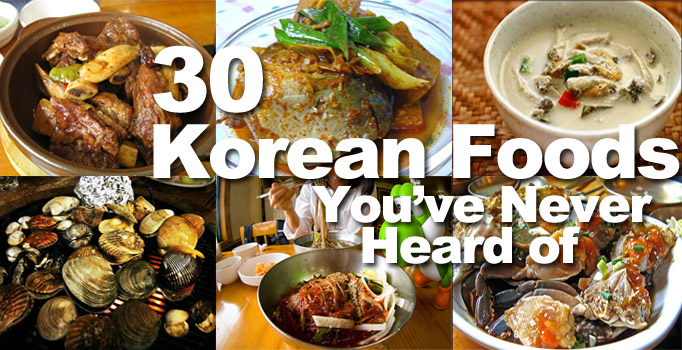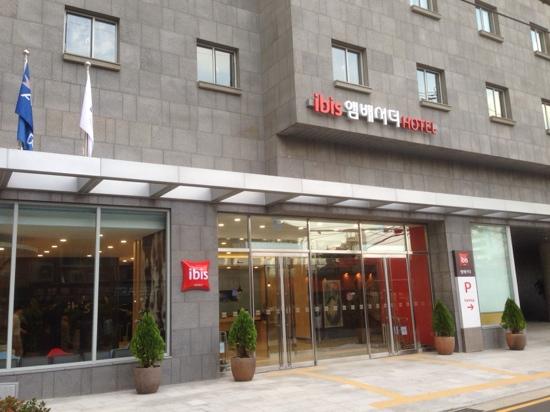30 Delicious Korean Foods You’ve (Probably) Never Heard Of
- agujjim
- altang
- andongjjimdalk
- bossam
- cheonggukjang
- daechanggui
- deulkketang
- galbi jjim
- galchijorim
- gamjaguk
- gamjatang
- ganjanggejang
- godeungeojorim
- golbaengi muchim
- gopchanggui
- gyeranjjim
- gyeranmari
- hobakjuk
- hoedeopbap
- jangjorim
- jjimdalk
- jjolmyeon
- jogaegui
- kimchimari guksu
- kongguksu
- kongnamulguk
- list of korean food
- maeuntang
- makguksu
- miyeokguk
- muguk
- nurungjitang
- someorigukbap
- suyuk
- where to eat in seoul
- yukhoe

Korean Seafood Dishes

7. Ganjangejang (간장게장) – soy marinated raw crabs – Raw crab might sound a bit strange, but this is a wildly popular dish in Korea. It’s also a lot of fun to eat too! You take a bite into a crab and suck the meat out and also take the crab shell and use it as a dish for your rice. Don’t forget to get all that yummy goo too! Sometimes you might get lucky at restaurants that serve this as banchan, but it’s a totally different experience when you’re eating this as the main course. Do it, yo!
8. Golbaengi muchim (골뱅이무침) – sea snail salad – Anything with the word snail in the title sounds gross, so it’s not the most marketable Korean food. But if you’re into spicy foods, salads and noodles, this is the perfect dish for you. Typically eaten as an anju (안주), a food to accompany alcohol, golbaengi muchim is one of the spicier options you’ll find on this list. But wash it down with some beer, and you’ll be straight 😉 (Click here for image)
 9. Godeungeo/galchi jorim (고등어/갈치 조림) – braised fish with radish – Godeungeo is mackerel and galchi is hairtail, and both are used in this really homely Korean dish. The chunks of mackerel and radish are cooked in a spicy soy-based sauce. The fish chunks are good, but some people love the radish even more. Whatever your preference, head over to Namdaemun Market and ask the tourist guides where you can find the jorim golmok (조림골목), a street with a bunch of restaurants selling this specialty.
9. Godeungeo/galchi jorim (고등어/갈치 조림) – braised fish with radish – Godeungeo is mackerel and galchi is hairtail, and both are used in this really homely Korean dish. The chunks of mackerel and radish are cooked in a spicy soy-based sauce. The fish chunks are good, but some people love the radish even more. Whatever your preference, head over to Namdaemun Market and ask the tourist guides where you can find the jorim golmok (조림골목), a street with a bunch of restaurants selling this specialty.
10. Agujjim (아구찜) – steamed angler – Fish is not always number one on people’s choice of Korean foods, but if you’re a fish lover, this spicy dish is a Korean food that will be sure to get your mouth on fire. Agujjim can get pretty expensive and range anywhere from 20,000 won to 50,000 won for a big pot. But it’s a great food to get delivered to your house or hotel in Seoul, so why not try ordering in for some spicy, fishy goodness you’ll pretty much find only sold in Korea. (Be careful of fish bones. These ones are sharp!) (Click here for image)
11. Hoedeopbap (회덮밥) – raw seafood bibimbap – This ultra healthy dish is similar to bibimbap in that you mix all the goodies in your bowl together. But the taste is very different as you’ll have raw seafood cubes, different types of vegetables and sauce to mix around. Hoedeopbap is low in fat and has all those healthy greens along with some rice to help keep you full. Here’s a simplified formula for hoedeopbap: salad + rice + hoe (raw seafood) = crazy delicious!
→ Next Page





29 Comments
Actually gamjatang is not potato stew. Gamja stands for the cut of the meat not the potato itself.
Jesse that is incorrect, gamja means potato in korean, and tang means soup in korean. so gamja tang is appropriately potato soup/stew. please do not spread misinformation like that.
You’re right but, there is a theory you didn’t know.
Pig’s backbones, one of the main ingredient of ‘gamjatang’, was called ‘gamjappyeo’ or ‘gamjeo(甘猪)’ in the past. As you know, ‘gamjappyeo’ and ‘gamjeo’ are similar with ‘gamja’ in their pronunciation.
Han and Jesse are right. The original gamja tang did not contain potatoes and some places still don’t use potatoes.
Actually I knew of all of them. My favorite is gamjatang
http://www.youtube.com/watch?v=ejW_UtYdSss
Actually what Jesse said is true. The cut of the meat is actually called kamja. lol.
I am fluent in Korean and I am dating a Korean (3 years).
Ask a korean if you are not sure
Also, you can get kamjatang without potato in it =)
… Also it’s not 덥밥, it;s 덮밥. Sorry!
… 누룽지^ ㅠㅠ
You are correct! Edited to reflect your corrections. Thanks everyone! 🙂
It feels good to know that I have eaten as well as made majority of these delicious Korean food at home. Korean food is very healthy and because of that, I am able to maintain my top physical shape. ^^
Nice Chris, glad it’s keeping you healthy! You’re a K-food expert 🙂
http://lmgtfy.com/?q=%EA%B0%90%EC%9E%90
Erica, try again.
The 감자 in 감자탕 refers to the 감자뼈, which is the cut of meat that is in the dish. @J: Try again, look up 감자뼈.
Jesse, all you did was replace the word soup with the word bone. There are both potato (usually), and bone in that soup. This seems like a common misconception, and probably was the way it has been called for years (with or without the potato). (Much like how ramen means pulled noodles, even though they are rarely hand pulled now.) Though that doesn’t mean it is correct. In fact I went to eat this the other day and specifically asked the lady this question, she said gamja means potato. It doesn’t get much clearer than that.
Here’s another example: gamja jorim. Guess what? gamja is potato, and jorim is the cooking/prep method. Are you telling me gamja jorim is actually some sort of bone side dish? Seems like it isn’t.
The facts are that gamja means potato, and i’m not seeing any exception. Maybe there is an exception, but you haven’t show me. Please show me otherwise. Also, yes I can read korean.
Actually historians disagree on whether the 감자 in 감자탕 refers to potatoes or a particular part of the pig. So both theories could be true.
J, you do know that words can have several meanings, right? ^^ The most common meaning of 감자 is potato, but the part of the pig that is used in 감자탕 is commonly referred to as 감자뼈. Whether it was always called 감자뼈 is something historians can’t agree on. Some think that it took on the name 감자뼈 because it was always being used in 감자탕. No one knows for sure.
I am a Korean native speaker, for what it’s worth.
Yea I understand. I speak chinese as well and we often have simliar words/phrases, that can mean completely unrelated things, or the once-used-for-this-situation-now-always-used-regardless-of-logic words/phrases.
I guess calling it a potato bone because it’s commonly used in that dish seems pretty reasonable. I just hope people know that the actual bone used isn’t a “potato bone” but the 등뼈, and occasionally the 무릎뼈 and possibly others depending on the shop. The shop I frequent uses a lot of 무릎뼈.
I always eat the italian version of (육회) , carppaccio. I loove raw beef
korean usually eat page 3. #12 Makguksu (막국수) after eating Dakgalbi(Spicy Grilled Chicken) as main meal !! <3 so delicious ^.^
Why does Korean still eat raw beef? Japanese use to eat raw beef but then people die from eating it. The raw beef in Japan got ban for having on the menu. There no cure for raw beef if you get sick or about to die.
I feel so hungry now.. ^^
btw there are some mistakes. 김치마리국수 -> 김치말이국수, and 계란마리 -> 계란말이.
one question: What am I supposed to do, when I get a soup and one bowl of rice? I mean, shoud I put the rice into the soup, stir it ad then eat, or eat one spoon of the soup and then rice, one spoon of the soup and again rice?
hi guys, big fan of Seoulistic.com … recently saw a popular singapore blogger copying THIS PARTICULAR article wholesale without crediting. not sure what i should do, so just letting you know.
Hi thanks for letting me know! If you could email at [email protected] the specific blog. I don’t mind reposting, but would like to kindly ask for crediting 🙂
육회 너무 맛있어 보인다!!!
hmm I have heard off some off these and i love Yukhoe, sometimes at school i’ll just by raw beef and eat that during my lunchbreak even though my friends can’t stand it (most of them are vegans)lol
j, jessie, Shut up!!
Is it strange that I know all of these? They aren’t too uncommon.
Can someone please explain what the GAMJA means in GAMJAtang. It is still very unclear to me what this soup consist of. Maybe ask J and Jessie to help again? Ps. I am an English native speaker if that helps. Thanks ㅜㅜ ㅎㅎㅎㅎㅎ lolol